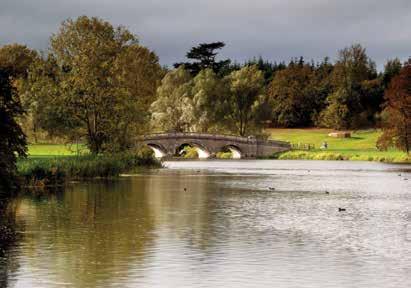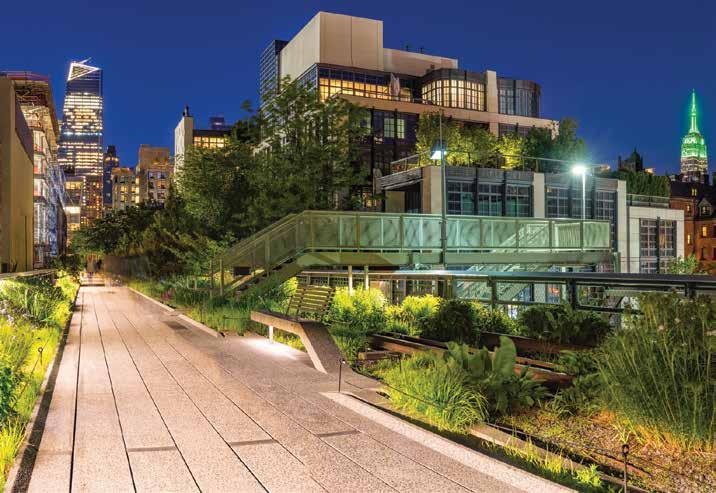
8 minute read
Home Design: Inspira
Gardens of Versailles—Photo by Dennis Jarvis
HOME DESIGN
Inspiration from Landscaping’s Greatest Hits
By Janice F. Booth
I suspect you’re sitting somewhere cozy, reflecting on the innumerable garden tasks you’ve completed, and you’re ready to dive head-long into preparations for the Holidays. This may be a perfect moment to cast your thoughts to a broader range of gardening ideas. And, with that in mind, I have gathered the names of gardeners and landscape designers who have left their marks on our vision of what is a beautiful garden.
Before wandering among these now-famous, perhaps familiar names, let me review the history, the evolution of gardens, beginning with the colonists, setting up their first dwellings in the new world:
• They were looking for a practical approach to planting a garden. 18th Century “dooryard gardens,” as they were called, allowed the colonists to keep a close eye on the small patch of vegetables and herbs planted there. A quick step outside the door allowed for harvesting whatever was needed for the cooking pot, without too much danger from predators or weather.
• By the early 19th Century, gardens were expanded to “kitchen gardens.” Fruit trees, veggies, herbs, and a few grape vines were cultivated, climate permitting. Such a garden was still focused on sustenance, though a few flowers, which could earn their keep, were introduced. Sunflowers, Marigolds, Echinacea, and Lavender were useful beauties. • By mid-century, there were bustling markets and folks had enough leisure and space to cultivate ornamental gardens. The mid-1800s saw rise to a fascination with horticulture, and the development of new varieties of plants as well as methods of disease and pest controls. One such development that has had a lasting impact on gardening, was the development of Pyrethrum, a natural pest control made from dried Chrysanthemum petals.
• The 20th century’s expansion of urban living produced gardens in small towns and cities that were softer and sometimes grander. Ladies Garden Clubs became popular, as did professional landscapers and gardeners. English gardens were influencing American gardens, with huge lawns, border beds, shrubbery borders, and ornamental water features.
• Mid-20th century’s two World Wars led American gardeners to return to feeding the family from one’s own garden. In 1943 there were 20 million “Victory Gardens,” where families grew vegetables, fruit, and herbs. These Victory Gardens were estimated to supply 40 percent of America’s produce requirements.
• The second half of the 20th century saw gardening undergo major changes and upheaval. The 1950s and ’60s “improved” gardening by introducing toxins developed to alleviate pests and diseases in plants, both in the garden and on the farm. The long-term results
were disastrous. In 1962, Rachel Carson shook the nation with her book Silent Spring. Dire warnings of the destruction of wildlife, and the eventual impact on the planet were heeded, and the first “Earth Day” was held in 1970. Organic gardening became the fashion.
• The 21st century has something old, the return of edible gardening. According to the National Garden Association, 1/3 of American households report growing food in their gardens. And there’s plenty of something new. Landscape Architect, Anoushka Feiler lists these qualities of 21st century garden design as:
1. Healthy-sustainable-ethical design. 2.Adaptive and flexible usefulness. 3. Responsible disaster mitigation, such as permeable surfaces for drainage and irrigation. 4. Recycling and upcycling through the use of sustainable materials. 5. Encouraging an emotional connection with the garden. 6. Socially responsive design that encourages spontaneous interactions with family, friends, and neighbors. 7. Digital accessibility, allowing connectivity in its many forms, in the garden. 8. Immersion, providing both quiet isolation and space for group activities.
So, now we have a simple overview of the development of gardens from Colonial days to the present. But, to see the development of the aesthetics of gardening, I think it’s helpful to consider some of the people who have left their mark on Western or European gardens.
JOHN TRADESCANT, THE ELDER
AND THE YOUNGER, were late 16th and early 17th century English adventurers and
Blenheim Palace Gardens
botanists, collecting rare and exotic specimens from the New World and Europe. In the case of Tradescant, The Younger, gardening and garden design were also his passions. Both father and son made excursions to the Colonies to collect seeds and plant specimens from the New World. The Elder devised a collection of artifacts from his travels, “The Ark,” which later became the first museum open to the public. The Younger gained renown for his garden designs, which included exotic flowers, fruit trees, and vegetables from the Colonies.
French landscape architect, ANDRÉ LE NÔTRE (1613–1700) may be familiar to you from

Alan Rickman’s 2015 movie A Little Chaos. (Like me, you may be one of the 300 people who wanted to see Kate Winslet as a rough-and-tumble gardener.) Le Nôtre, the landscape architect to Louis the XIV, designed the gardens for Versailles, Fontainebleau, and the Tuileries, among others. His designs were based on Classical theories of order, balance, and symmetry.

Englishman, LANCELOT “CAPABILITY” BROWN (1716–1783) is almost a “household word,” at least among gardeners. His philosophy of garden design—Romanticism—reflected the wildness of nature. Though dead for over 200 years, Capability Brown gained recognition and even fame as a historical figure in the Tom Stoppard 1993 play, Arcadia, wherein Capability Brown’s landscape design plays a significant role. He was known by the nickname “Capability” both for his own abilities and his turn of phrase, “…of course, this property has capability for improvement.” And that argument must have worked; he is recognized for the creation of more than 190 English parks. Brown’s designs used the flowing vistas of English mead-

ows, naturalistic ponds and streams, and copses or clumps of perfectly situated trees. His designs still flourish in several castle and palace gardens, including Blenheim Palace and Harewood House.
HUMPHRY REPTON, (1752–1818) is considered Brown’s successor. Repton began his career polishing and upholding the work Brown had made famous, but later in Repton’s career, his own mark on landscape design was the addition of “Vistas,” or views of distant steeples, hillsides, or buildings. He introduced meandering parkways or carriage roads, focusing on the pleasure ride. Repton was interested in the picturesque. Perhaps Repton’s most permanent mark on landscape design is his “Red Book.” Named for the binding, these books contained detailed drawings and watercolor renderings of Repton’s vision for a particular project. He added “overlays” to show the garden or park’s growth over time. Not only did the Red Book help his business; the idea of a presentation book was soon picked up and used by landscape designers on both sides of the Atlantic.
FREDERICK LAW OLMSTEAD
(1822–1903) is perhaps the most famous American landscape architect. His parks and garden designs are distinguished by his eye for the natural and recognition of the relationship between the visitor and nature. His designs, which stand the test of time, are too numerous to list here, but New York City’s Prospect and Central Parks are among them. He worked on the creation of Niagara Reservation in Niagara Falls, New York, the oldest national park, as well as a gem-like string of public parks and parkways along the East Coast. Olmstead worked tirelessly caring for the sick and wounded during the Civil War as Secretary of the Sanitary Commission, later to become the American Red Cross. You may have read Erik Larson’s book, The Devil In the White City, about the 1893 Chicago World’s Fair. Olmstead provided the landscaping of the Fair. Perhaps most vital of his accomplishments was his early championing of environmentalism and the protection of our nation’s exceptional natural beauty and bounty.
GERTRUDE JEKYLL (1843–1932) designed over 400 notable gardens in England and abroad. She wrote more than 1,000 articles on gardening and garden design. She was also a renowned painter and photographer. Her approach to landscape design reflected her artist’s eye and her admiration for the Arts and Crafts movement. The Romantic spirit and detailed craftsmanship were hallmarks of her work. Her influence was felt in both American and Britain, as impressionistic and vibrant flowers and arrangements gained in popularity. Perhaps Jekyll’s most renowned garden was the one she created for her sister, Caroline, in Venice in the mid-1880s. Named the Eden Garden for Caroline’s husband Frederic Eden, it was recognized for its exceptional beauty. Journalists Peter Parker and James Fenton wrote, “The garden featured a large number of willow pergolas covered in roses, and extensive plantings of Madonna lily as well as other English flowers. Paths around the garden were surfaced with local seashells. There were lawns, courts, and a walk lined with cypresses.”
Contemporary “Greats” are a bit harder to identify; however, three names are always included in the short list. Their influences, long-term, are still being measured.
ROBERTO BURLE MARX (1909–1994) was a Brazilian landscape architect and ecologist. He was the first notable voice to champion the protection of the rain forests. He worked in tropical garden design, offering the visitor the lavish
beauty of Birds of Paradise, papaya, ferns, and orchids. Marx’s designs often included water gardens.
PIET OUDOLF (1944-present) embraces a naturalistic and ecologically sustainable approach to landscape and garden designs. He is noted for creating the High Line in New York City. “My biggest inspiration is nature. I do not want to copy it, but to recreate the emotion.” Other renowned gardens bearing Oudolf’s distinctive touch are the Lurie Garden in Chicago and the Oudolf Garden, Belle Isle, Detroit. In addition, Oudolf has completed gardens throughout Europe.
THOMAS “TOMMY” CHURCH (1902–1978) championed the Modernist or California-style in garden design. Outdoor living and the outdoor room were his hallmark innovations. Four characteristics of his work were: (1) function as well as beauty, (2) unity of house and garden, (3) simplicity, and (4) scale, by means of engaging the structure(s) with the surroundings. His legacy comes through his books on garden design rather than specific gardens, Gardens Are for People (1955) and Your Private World: A Study of Intimate Gardens (1969).
We are fortunate to have many famous public and private gardens along the Eastern seaboard, particularly in the Brandywine Valley region of Pennsylvania and Delaware. I’m compiling a personal list of gardens I can drive to in our region. I plan to see for myself some of the brilliant, timeless beauty created by these landscape and garden designers.













